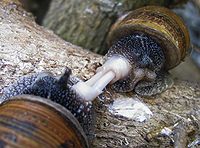
Photo from wikipedia
The occurrence and extent of multiple paternity is an important component of variation in plant mating dynamics. However, links between pollinator activity and multiple paternity are generally lacking, especially for… Click to show full abstract
The occurrence and extent of multiple paternity is an important component of variation in plant mating dynamics. However, links between pollinator activity and multiple paternity are generally lacking, especially for plant species that attract functionally diverse floral visitors. In this study, we separated the influence of two functionally distinct floral visitors (hawkmoths and solitary bees) and characterized their impacts on multiple paternity in a self‐incompatible, annual forb, Oenothera harringtonii (Onagraceae). We also situated pollinator‐mediated effects in a spatial context by linking variation in multiple paternity to variation in plant spatial isolation. We documented pronounced differences in the number of paternal sires as function of pollinator identity: on average, the primary pollinator (hawkmoths) facilitated mating with nearly twice as many pollen donors relative to the secondary pollinator (solitary bees). This effect was consistent for both isolated and nonisolated individuals, but spatial isolation imposed pronounced reductions on multiple paternity regardless of pollinator identity. Considering that pollinator abundance and pollen dispersal distance did not vary significantly with pollinator identity, we attribute variation in realized mating dynamics primarily to differences in pollinator morphology and behaviour as opposed to pollinator abundance or mating incompatibility arising from underlying spatial genetic structure. Our findings demonstrate that functionally distinct pollinators can have strongly divergent effects on polyandry in plants and further suggest that both pollinator identity and spatial heterogeneity have important roles in plant mating dynamics.
Journal Title: Molecular Ecology
Year Published: 2017
Link to full text (if available)
Share on Social Media: Sign Up to like & get
recommendations!